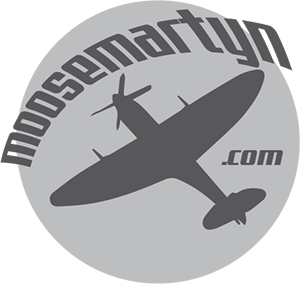In 2013 I visited the Battle of Britain memorial on the Thames in London. Excitedly I looked for my grandfathers name, but never found it. I wondered if they had mixed up his four names and looked for him under different surnames. But no. I looked online, everywhere that has lists of names of those that are among ‘the few’, and he is listed on none of them.
In June of 2015 I began the development of, and research for, the first moosemartyn.com. An undertaking which took seven months before its launch on December 14, 2016. During that time I tried many times to ascertain how and why Bill came to have the B.o.B. clasp. I approached a couple of experts, and the people at the Battle of Britain memorial, but received little more than a shrug. On the original website there was an ‘Awards’ page where I outlined how he had earned the DSC and Bar, M.i.D.’s and explained the Service Medals and clasps. I left out the B.o.B. clasp, because I could not explain when and why.
Here, clearly, is Lt. Cdr. William W. H. Martyn’ Battle of Britain clasp. What is not clear, is how he came to have it.

Picture of Bill’s medals
Bill served on 801(FF) squadron during the Battle of Britain and for most of June to November 1940 the squadron was stationed at RNAS Hatston, in the Orkney’s. There are only (officially) two FAA squadrons that took part; 804 and 808. As it happens 804 was stationed at RNAS Hatston during the same period. There are two key differences between the two: 804 was under RAF Fighter Command, and 801 wasn’t. And secondly, 804’s operations were over British territory (primarily protecting Scapa Flow) while 801 was participating in operations over Norway (from Hatston and HMS Furious). 801 was primarily operating the Blackburn Skua, a dive bombing/fighter aircraft which was well suited to attacking shipping and ground installations, but was inadequate for engaging fighters. 804 was operating Gloster Sea Gladiators, the last bi-plane developed for combat in WWII. The Gloster (Sea) Gladiator is one of the aircraft considered to have taken part in the Battle of Britain, but the Blackburn Skua is not.
Although 801 would have faced resistance from Luftflotte 5 (which had been involved in the invasion of Norway and was based there through-out the war) in the North Atlantic and over Norway, the fact that they were not operating certain aircraft and were not assigned to RAF Fighter Command seems to have ensured they were left out by the ‘list makers’. The original list included no Fleet Air Arm squadrons or pilots (unless the pilot was assigned to an RAF sqn. that was on the list). 804 and 808 squadrons were added sometime after 1960. Apparently the criteria for inclusion has changed at times, with some squadrons and pilots who were on the original list being removed, and others added.
There is the possibility that the Admiralty deemed that Bill had met the criteria and issued him the clasp. Here is an excerpt from THE ORIGINS OF AIRCREW WHO FOUGHT IN THE BATTLE OF BRITAIN Dr Tony Mansell:
Nos 804 and 808 Sqns of the Fleet Air Arm (FAA) operated under Fighter Command control during the Battle along with a further twenty-five naval pilots who flew on loan to RAF squadrons. The Navy, being a law unto itself; dealt with the issue of Clasps in Admiralty Fleet Orders (AFO) 2686 and 3115 of 1945. The Admiralty were not subject to an AMO for permission to do that but should have taken note of the RAF squadrons which the relevant AMOs had accredited.
I am hoping to see AFO’s 2686 and 3115 when I visit Kew in the Fall.
From the Battle of Britain Memorial website, “There are debates to this day about the eligibility criteria for the Clasp and new names are sometimes added to the list, but the Battle of Britain Memorial Trust has no jurisdiction over the list of men known as the Few.”
From the gov.uk website:
Clasps are worn on the ribbon of the 1939 to 1945 Star.
To apply for the Battle of Britain Clasp to the 1939-45 Star, you must have:
- served as aircrew on a fighter aircraft
- been engaged in the Battle of Britain between 10 July 1940 and 31 October 1940
Could they be any more vague?
What is considered to have ‘been engaged in the Battle of Britain’?
If it is to have been operating fighter aircraft against German aircraft during the prescribed dates, than 801 is an obvious inclusion. Although the Blackburn Skua is not strictly a ‘fighter’ it certainly engaged the enemy as one.
I find myself with more grey hairs than when I began to write this. I expect there are many more to come.
Lastly (for now), were all 801 pilots given the clasp, or just Bill?
Either way, the questions of when and why persist. Moreover, why does he have the clasp, but is not listed as having been a participant in the Battle of Britain? The two are intrinsically tied.
This does posit another question: Was Bill Martyn given the clasp in error?
To be continued . . .

Comments 1
Great question! I have done some research at KEW and may have some useful insight. My wife’s father also served with FAA 801 Squadron serving on HMS FURIOUS and based at Hatston the same time as your grandfather. His service record indicates award of the Battle of Britain clasp, but he has also been omitted from the memorial. I have been working on writing the story of Petty Officer (Pilot) Richard H. Williams (retired as Lt Cdr, RN) for some time so that he is not forgotten. My contact details are below.